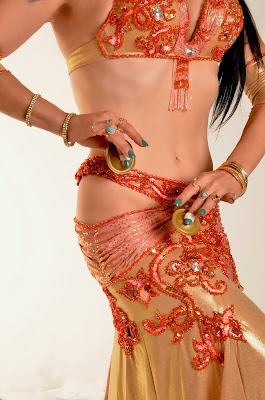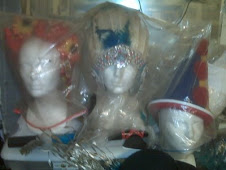Classic
American Cabaret belly dance-also known as Vintage Orientale- is currently
having A Moment. The style is
experiencing a resurgence, becoming very
popular with younger dancers , many of whom were not even born when this type
of dancing was in it’s heyday during the 1960's through the 1980's.
When
I began my career in the early 1990’s, I was trained primarily in the Egyptian
style, but Vintage Oriental was still very much with us, especially for
restaurant dancers. Audiences expected
to see a lot of veil and finger cymbal
work.
American
Cabaret doesn’t just use music from one
genre or country- it’s a lovely pastiche of many types of rhythms and songs
from all over the Middle East,
North Africa and Central Asia. Finger cymbals and extensive veil work
are a couple of the hallmarks of this style,
and I often get requests in my
workshops to show some of the exotic veil wraps that were used “back in the day”.
 |
| The old-school wrap Photo: Lapis |
If
you’d like to experiment with this style, enter with your veil wrapped around
you. You can use a separate veil to enter, or just come onto the stage with
your cymbals a-blaze. After an opening
piece, do a slow taxim or chiftetelli piece,
and incorporate some veil moves.
For
starters, try this simple, pretty wrap:
Extend your left arm out and parallel to the
floor. Drape your veil length-wise over it so equal halves hang in front and in
back. Make sure the hems are even and
straight. Pick up the front half of the veil and bring it across your chest,
tucking the long hem into your bra straps and the left and right sides.
Tuck the corner of the gathered fabric into
your costume at the right hip.
Now, take the portion of the veil that was hanging
on the back of your left arm, gather it up at the far corner, and tuck that it into the center back
of your costume. If you like, you can also tuck the front part of the veil in at each hip, and blouse it out for a billowy Grecian Goddess effect.
To unwrap, take the portion of the veil from
the bra straps with both hands and slowly pull the veil way from you, so that
the end tucked in your costume’s right hip releases. Play with the veil like
this for a few moments, holding it in front of you, moving or spinning slowly.
When you want to release the end of the veil that was tucked into the back,
simply pull the hem of the entire veil away from you, and it will come
un-tucked easily.














